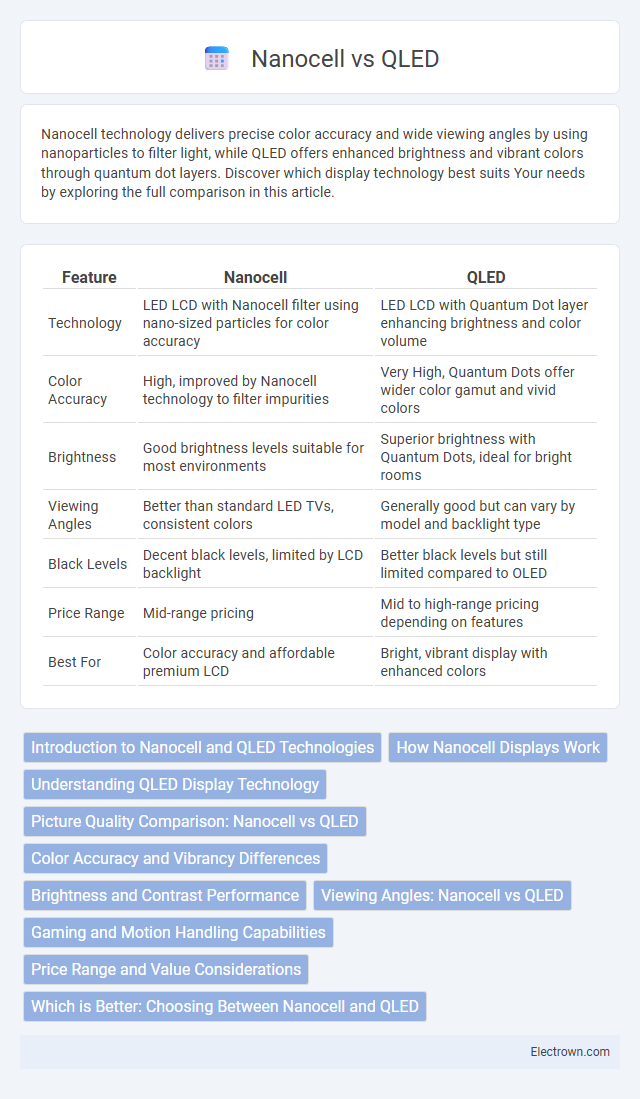Nanocell technology delivers precise color accuracy and wide viewing angles by using nanoparticles to filter light, while QLED offers enhanced brightness and vibrant colors through quantum dot layers. Discover which display technology best suits Your needs by exploring the full comparison in this article.
Table of Comparison
| Feature | Nanocell | QLED |
|---|---|---|
| Technology | LED LCD with Nanocell filter using nano-sized particles for color accuracy | LED LCD with Quantum Dot layer enhancing brightness and color volume |
| Color Accuracy | High, improved by Nanocell technology to filter impurities | Very High, Quantum Dots offer wider color gamut and vivid colors |
| Brightness | Good brightness levels suitable for most environments | Superior brightness with Quantum Dots, ideal for bright rooms |
| Viewing Angles | Better than standard LED TVs, consistent colors | Generally good but can vary by model and backlight type |
| Black Levels | Decent black levels, limited by LCD backlight | Better black levels but still limited compared to OLED |
| Price Range | Mid-range pricing | Mid to high-range pricing depending on features |
| Best For | Color accuracy and affordable premium LCD | Bright, vibrant display with enhanced colors |
Introduction to Nanocell and QLED Technologies
Nanocell technology utilizes a layer of nanoparticles to filter and refine colors, enhancing picture accuracy and vibrancy on LED LCD screens. QLED, or Quantum Dot LED, employs quantum dots that emit precise colored light when illuminated, resulting in brighter images with a wider color gamut. Understanding these distinct approaches helps you choose the best display technology for enhanced viewing experiences.
How Nanocell Displays Work
Nanocell displays use a layer of uniform nanoparticles to absorb unwanted wavelengths of light and enhance color accuracy by filtering out impurities in the backlight. This technology improves color purity and viewing angles by ensuring more precise color reproduction compared to traditional LCD screens. Unlike QLED, which utilizes quantum dots for light emission, Nanocell technology focuses on refining the light before it reaches the LCD panel for improved image quality.
Understanding QLED Display Technology
QLED display technology utilizes quantum dots, microscopic semiconductor particles that emit pure, precise colors when illuminated by an LED backlight, enhancing brightness and color accuracy. This technology enables QLED screens to achieve higher peak brightness and a wider color gamut compared to traditional LCDs, making them ideal for vivid HDR content. Manufacturers like Samsung integrate QLED panels with advanced backlighting and pixel control to deliver sharp, vibrant images with improved energy efficiency.
Picture Quality Comparison: Nanocell vs QLED
Nanocell technology utilizes a layer of nanoparticles to filter and refine color output, resulting in more accurate and vibrant colors, especially in mid-range TVs. QLED, leveraging quantum dot technology, delivers higher brightness levels and a wider color gamut, enhancing HDR performance and overall picture clarity. In terms of picture quality, QLED often outperforms Nanocell in brightness and contrast, while Nanocell offers more precise color accuracy and wider viewing angles.
Color Accuracy and Vibrancy Differences
Nanocell technology enhances color accuracy by using a layer of uniform nanoparticles that filter and refine light wavelengths, resulting in more precise and natural hues. QLED displays utilize quantum dots that emit pure, saturated colors when illuminated, delivering higher vibrancy and brightness levels. While Nanocell excels in reproducing subtle tonal variations, QLED often provides more intense colors and better performance in bright environments.
Brightness and Contrast Performance
Nanocell displays utilize advanced nanoparticles to enhance color accuracy and brightness by filtering out dull colors, achieving peak brightness levels around 450 to 600 nits. QLED technology, based on Quantum Dot LEDs, offers superior brightness performance with peak luminance often exceeding 1,000 nits, resulting in more vivid highlights and better HDR effects. Contrast performance on Nanocell TVs is improved compared to standard LCDs but generally lags behind QLED's enhanced dynamic range and deeper blacks achieved through effective backlight control and higher peak brightness.
Viewing Angles: Nanocell vs QLED
Nanocell displays offer wider viewing angles compared to QLED, maintaining consistent color accuracy and brightness when viewed from the side. QLED screens may experience color shifting and reduced brightness at extreme angles, limiting optimal viewing positions. Choosing a Nanocell TV can enhance your experience in rooms where multiple viewers watch from different angles.
Gaming and Motion Handling Capabilities
Nanocell displays offer precise color accuracy and fast response times ideal for gaming, with reduced motion blur enhancing fast-paced gameplay. QLED technology provides higher brightness levels and better HDR performance, delivering vivid visuals and smooth motion handling for immersive gaming experiences. Both technologies support high refresh rates, but QLED often excels in motion clarity due to superior backlight control and local dimming features.
Price Range and Value Considerations
Nanocell TVs typically fall within a mid-range price bracket, offering vibrant colors and improved viewing angles at a competitive cost, making them a strong value choice for budget-conscious buyers. QLED models often command higher prices due to advanced quantum dot technology that delivers brighter images and better contrast, providing enhanced performance for those willing to invest more in premium picture quality. Your decision should weigh the balance between affordable innovation with Nanocell and superior brightness with QLED, ensuring the best value for your specific viewing needs.
Which is Better: Choosing Between Nanocell and QLED
Nanocell technology offers superior color accuracy and wider viewing angles due to its use of nanoparticle filters that refine RGB spectrum, making it ideal for cinematic experiences in bright rooms. QLED TVs, leveraging quantum dot technology, provide higher peak brightness and better energy efficiency, excelling in vibrant HDR content with enhanced contrast levels. Choosing between Nanocell and QLED depends on usage scenarios: Nanocell suits environments prioritizing color fidelity and wide-angle viewing, while QLED is better for bright spaces demanding intense brightness and dynamic picture quality.
Nanocell vs QLED Infographic

 electrown.com
electrown.com